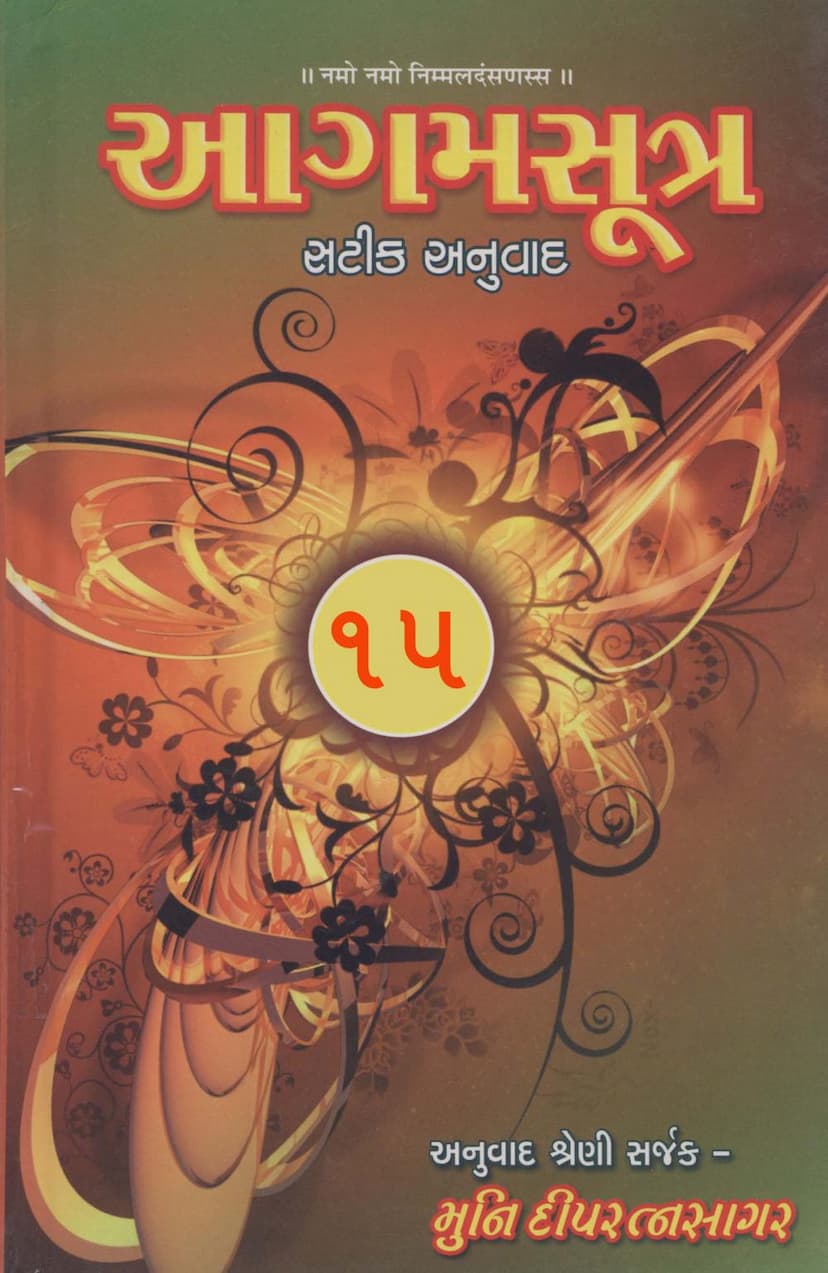Agam 10 Prashnavyakaran Sutra Satik Gujarati Anuvad
Added to library: September 1, 2025

Summary
This document is the Gujarati translation and commentary of the Jain Agam Prajnavyakaran Sutra, which is the tenth Anga (limb) of the Jain scriptures. It is part of a larger series titled "Agam Satik Anuvad" (Commented Agam Translation) compiled by Muni Deepratnasagar. This specific volume, part 15, focuses on the Prajnavyakaran Sutra and includes commentaries for its ten Adhyayanas (chapters).
Key aspects of the text:
-
Title: Agam 10 Prashnavyakaran Sutra Satik Gujarati Anuvad (Agam 10, Prajnavyakaran Sutra, with Commentary, Gujarati Translation)
-
Author/Compiler: Muni Deepratnasagar
-
Publisher: Deepratnasagar
-
Volume: Part 15 of the Agam Satik Anuvad series.
-
Content Focus: The Prajnavyakaran Sutra, one of the foundational Angas of the Agamas. The text describes its structure as having ten Adhyayanas (chapters).
-
Purpose: To provide a detailed explanation and translation of the Prajnavyakaran Sutra in Gujarati, making its complex teachings accessible to a wider audience.
-
Commentary Style: The translation is accompanied by a Satik (with commentary) analysis, which delves into the philosophical and practical aspects of the sutra.
-
Spiritual Homage: The text begins with invocations to Lord Neminath and spiritual gurus like Shri Anand-Kshama-Lalit-Sushil-Sudharma Sagar.
-
Acknowledgments: The text expresses gratitude to various individuals and organizations, including Acharya Shri Hamsachandrasuri, Acharya Shri Harshsagar Suri, and the Jain community of Surat, for their financial and inspirational support in the publication of this series.
-
The Prajnavyakaran Sutra's Content (as outlined in the beginning and within the text):
- The name itself, Prajnavyakaran, is interpreted as "that which elaborates on wisdom" or "the grammar of wisdom."
- It's stated to have two Shrutakandhas (sections): Ashravadvara (the gate of influx) and Samvaradvada (the gate of stopping influx).
- The Ashravadvara section is described as having five Adhyayanas, and the Samvaradvara section also has five.
- The text then delves into the detailed explanation and commentary of these Adhyayanas. The provided pages focus on the Ashravadvara and Samvaradvara, specifically covering concepts like:
- Ashrava (Influx of Karma):
- Pranatipaat (Violence/Killing) - Discussed extensively with numerous descriptive names for violence and the suffering it causes in various lifetimes and hellish realms.
- Mṛṣāvāda (False Speech) - Explains different types of false speech, their consequences, and philosophical viewpoints that contradict Jain teachings.
- Adattadana (Stealing/Taking what is not given) - Details various forms of theft, the punishments, and the cycle of suffering associated with it.
- Abrahmcharya (Unchastity/Lust) - Discusses the detrimental effects of lust, its various forms, and the suffering it leads to, including detailed descriptions of hellish punishments and the lives of divine beings and heroes.
- Parigraha (Possession/Attachment) - Explains attachment as the root of all suffering, illustrating its pervasive nature and the endless cycle it perpetuates.
- Samvara (Stopping the Influx of Karma):
- The text outlines five types of Samvara: Ahimsa (Non-violence), Satya (Truthfulness), Dattadanu (Accepting what is rightfully given), Brahmacharya (Celibacy/Chastity), and Aparigraha (Non-possession).
- Each of these vows is elaborated with its significance, its importance in the path to liberation, and the virtues associated with it. The text emphasizes the meticulous practice required for these vows, detailing various aspects of conduct, mental discipline, and ethical behavior.
- Ashrava (Influx of Karma):
-
Extensive Detail: The commentary is remarkably detailed, especially in its descriptions of the consequences of negative actions (Ashrava) and the virtues of positive actions (Samvara). The suffering caused by Ashrava is vividly portrayed, often with graphic descriptions of hellish punishments and the cycle of rebirth. The virtues of Samvara are presented as the path to spiritual elevation and ultimate liberation.
In essence, this volume is a comprehensive spiritual and philosophical guide to the Prajnavyakaran Sutra, aiming to educate and inspire its readers towards righteous conduct and spiritual progress according to Jain principles.